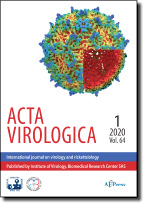Acta Virologica Vol.64, No.3, p.344-351, 2020
|
| Title: A new single nucleopolyhedrovirus isolate from Cabbage looper, Trichoplusia ni (Hubner) (Lepidoptera: Noctuidae): Detection, characterization and virulence |
| Author: G. B. Eroglu, R. Nalcacioglu, M. Nakai, Z. Demirbag |
|
Abstract: This study was focused on the detection, characterization and virulence of a new baculovirus isolate from the larvae of cabbage looper, Trichoplusia ni (Hubner) (Lepidoptera: Noctuidae). T. ni is a polyphagous pest, and it has cosmopolitan distribution. An infected T. ni larvae was collected from a cabbage field in Turkey. Scanning electron microscopy studies showed the presence of typical occlusion bodies (OBs) with average size of 0.76 to 1.46 µm in the collected larvae. Since the virions have single nucleocapsid within the envelopes, the isolate was named as Trichoplusia ni single nucleopolyhedrovirus Turkey isolate (TrniSNPV- TR). The total genome of the TrniSNPV-TR was determined as 122.9 kb in size. Sequence analysis of the amplified late expression factor 8 (lef8), late expression factor 9 (lef9) and polyhedrin (polh) genes showed that the virus is a new isolate of nucleopolyhedroviruses and close to Trichoplusia ni SNPV isolates mentioned in the literature. However, this is the first study for the detection and characterization of a baculovirus from T. ni in Eurasian region. Insecticidal activities of the TrniSNPV-TR isolate (106 OBs/ml-1) against neonate, 3rd and 5th instar larvae of T. ni and Helicoverpa armigera showed 98%–91%, 91%–87% and 65%–60% mortalities, respectively, within 14 days. LC50 of TrniSNPV-TR was determined as 2×103–9×103, 3×104–7×104 and 1×105–2×105 OBs/ml on neonate, 3rd and 5th instar larvae, respectively. All these results showed that, TrniSNPV-TR has good potential to be utilized as a bio-pesticide against T. ni larvae in the future.
|
|
| Keywords: baculovirus; nucleopolyhedrovirus; Trichoplusia ni; TrniSNPV-TR; biological control |
|
|
Published online: 16-Sep-2020
|
| Year: 2020, Volume: 64, Issue: 3 |
Page From: 344, Page To: 351 |
doi:10.4149/av_2020_312
|
|
 download file download file |
|
|
|
|
 download file
download file
